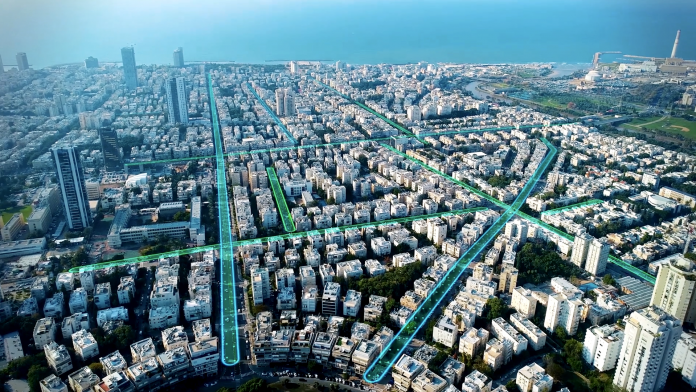Maher Kasskawo of Electreon explores the benefits of wireless charging throughout the day for improved fleet operations.
Maher Kasskawo is an e-mobility specialist with multiple years of experience from the largest Nordic e-bus operator, charging systems operations and implementations. Here, he discusses the benefits of supplemental wireless charging for electric vehicles (EVs), explaining that a few minutes of opportunity charging, distributed throughout the day, can provide e-fleets with significant operational improvement and battery cost savings.
There are certain use cases where wireless charging not only makes operational sense but can also offer additional benefits that plug-in charging cannot. Typically, plug-in charging adds unnecessary operational complexity, for example, at locations where high vehicle manoeuvrability means there is little to no space available for charging stations. In contrast, wireless charging can be fully integrated into city or depot infrastructure with no visible parts, removing the need for additional space to house charging infrastructure. Conductive charging also has moving parts, such as pantographs for example, and leads to higher long-term maintenance costs, caused by general wear of equipment, such as cables.
Wireless charging does not always have to replace conductive charging; it can supplement it, offering quantifiable benefits, including increased operational hours, reduction in battery energy capacity and cost savings when deployed at scale. Using real world data, this report looks at electric bus fleets in the city of London and explores the benefits of wireless charging throughout the day for improved fleet operations.
Wireless charging can support electrification of public transport fleets
In London, the government is working to reduce tailpipe emissions and has begun transforming their fleet of over 9,300 buses in London, serving 675 bus routes1, into zero-tailpipe emissions vehicles. The UK government hopes that by 2041, 80% of journeys in London will be undertaken using public transport, by bicycle, or on foot2. Over 500 e-buses are already zero emission at the tailpipe. As part of a transition towards cleaner transport, wireless charging can support existing plug-in charging solutions for public transport. We explore the benefits of both stationary and dynamic wireless charging solutions for e-bus fleet operators.
 Scenario: Static wireless opportunity charging can extend EV operational time
Scenario: Static wireless opportunity charging can extend EV operational time
Our modelling shows that by including short bursts of wireless charging, for example, as little as just a few minutes at a time, operational hours can be increased. Charging can take place either at the bus end stations or at stations along the bus’s route, enabling charging to occur at any point throughout the operational day of the e-bus. To understand how this opportunity charging strategy supports e-fleet mobility, we can start by assessing the typical routes and number of journeys that a public bus might take. A typical city bus route is around 13 miles (20 km)3.
Today, on average, an e-bus carries around 350 kWh battery, although some buses carry significantly larger batteries to enable fleet operators to complete their scheduled operational trips without the need to be taken out of operation to charge. Assuming an e-bus begins its first trip of the day with a fully charged battery, with no opportunity charging on-route, the bus would be able to complete 10 trips before having to be sent back to the depot/garage to charge. At this point, the battery State of Charge (SoC) level would be at around 35-40% assuming energy consumption of 1,1 kWh/km and operational speed of 20 km/h. This is assuming that the weather on the day is pleasant—not too hot and not too cold—as climatisation systems play a big role in EV energy consumption. In this scenario, 35-40% SoC is considered the nominal battery SoC buffer to account for external factors such as climate and other factors that can influence the energy consumption (even including some battery degradation).
Assuming eight minutes of static wireless charging at the end of each round-trip, the supplementary wireless static charging can enable an e-bus to complete up to 20 total roundtrips before its battery level gets too low, forcing the e-bus to return to the depot/garage to charge4. We are also assuming that the e-bus is fitted with three receivers offering 30 kW each meaning 90 kW total charging power5 with a power transfer efficiency of 92% during the wireless static charging from grid supply to the bus’ battery energy storage. As Electreon’s technology is used for just eight minutes after each ~12.5 mile (20 km) round trip, this will prevent the battery SoC from dropping too low throughout the day. And with 20 total round-trips possible, each one averaging around 12.5 miles (20 km), this will result in 250 miles (400 km) of daily driving distance (the number of trips multiplied by the average trip distance). This means a full daily utilisation of the bus as the operational time exceeds 20 hours and the bus needs to fully charge at the depot for the next day of operation.
Scenario: A combination of Static and Dynamic wireless opportunity charging can optimise battery cost
Taking the assumptions from our previous scenario, we can look at the benefits offered by additional dynamic wireless charging to e-buses operating on daily routes.
Along a 12.5 mile (20 km) round trip route for an e-bus, with eight minutes of static charging at the end of each completed round trip and additional charging from a dynamic wireless Electric Road System (ERS) that comprises just 15% of the total round trip route (1.8 miles or 2.9 km), we can keep the e-bus charged indefinitely with approximately 90 kW grid supply to the dynamic charging road. This still assumes a 12mph (20 km/h)6 average operational speed of the e-bus (which is considered fast7). Under the above conditions when combined with wireless dynamic charging, the e-bus can technically be fully operational for an entire 24-hour period and its battery will remain at optimal SoC levels throughout the day. This method of charging could in theory eliminate the need for end-of-day or overnight charging at the depot entirely. With this scenario, it becomes much easier to maintain the optimal SoC levels to secure the lifetime of the battery. This has additional transport energy distribution benefits, as we explored in this article.
Aside from potential increases in e-bus operational uptime, there are also opportunities to save on battery costs. The dynamic wireless charging along the route allows the bus to have a reduced battery energy capacity. E-buses on average have a battery energy capacity of around 350kWh to perform daily operations and many public transport operators are now purchasing e-buses with battery capacities of 500kWh or more, just to complete the operational schedule of the bus. Reducing the bus fleet’s battery sizes has numerous other benefits too. Smaller batteries also reduce the weight the bus must carry, making the vehicle more energy efficient and allowing for additional passenger carrying capacity, and it reduces the environmental impacts of the vehicle battery manufacturing.
In real world cases, combined static and dynamic wireless opportunity charging has showcased battery reduction possibilities of much greater than 50%. In our Tel Aviv public e-bus project, an e-bus used a 42kWh in place of a 350kWh battery. With the above scenario parameters, for example, combined static wireless charging and a wireless dynamic ERS deployed along 15% of the road could in theory, allow the battery energy capacity of those buses to be reduced by up to ~ 95%. It would be reasonable, therefore, to reduce the battery capacity to about 50 kWh to secure variations in operational conditions affected by external factors such as climate, for example. In this case, electrifying 10 buses that operate along this route could result in the public transport operator benefitting from a total potential saving of $39,6008. If a route that serves 10 e-buses is electrified, the bus operator could save up to $396,000 on battery costs for those buses.
This cost saving opportunity is especially possible when specific buses are dedicated to certain lines, for example, Bus Rapid Transit (BRT) scenarios. BRT buses can be fully optimised for the planned lines they operate on, which makes it possible to optimise battery energy capacity to reduce it significantly if wireless dynamic charging is used. Where more e-buses can use the same stretches of dynamic wireless charging along their journey, further savings can be made for the operators in terms of battery size and increased operational hours. Once the charging infrastructure is installed at a particular location, it can serve as a shared charging asset for additional e-fleets and other EVs.
Static and dynamic wireless charging can support fleet electrification
There are plenty of opportunities presented by wireless EV charging technology, which can enhance plug-in charging or replace it altogether, as required by each individual fleet operator. Research into this technology continues, and to date there are five pilots testing our wireless Electric Road Systems in real-world conditions. There is also ongoing research on whether opportunity-based charging at regular intervals throughout the day with less power, compared to charging at less frequent intervals with higher power9, can extend battery lifespan and decelerate battery degradation.
Notes and References
- https://tfl.gov.uk/corporate/about-tfl/what-we-do#on-this-page-0
- https://tfl.gov.uk/corporate/about-tfl/what-we-do#on-this-page-0
- We assume this to be a typical bus route length in London as according to research, urban buses on all day service will normally operate between 150 and 300 kilometres per day and the average bus route length is around 6-7 miles (9-11 km). A roundtrip, starting and finishing at the bus end-station would therefore total around 13 miles on average (~ 20 km). https://assets.publishing.service.gov.uk/government/uploads/system/uploads/attachment_data/file/929992/annual-bus-statistics-year-ending-march-2020.pdf; https://ppiaf.org/sites/ppiaf.org/files/documents/toolkits/UrbanBusToolkit/assets/1/1c/1c11.html; https://comptroller.nyc.gov/wp-content/uploads/documents/Bus_Route_Profiles_2017.pdf
- Here’s how we calculated this: we assume that the e-bus with 350 kWh battery consumes energy at a rate of 1.1 kWh/km# at an average operational speed of 20 km/h. On a ~12.5 mile (20 km) round trip we can calculate that the e-bus is therefore consuming 22 kWh (1.1 * 20) after completing each round trip.
- Electreon’s vehicle-side hardware is modular, allowing higher power to be supplied to commercial vehicles (e.g. buses and trucks) with more energy by increasing the number of vehicle receivers fitted to the EV. For our public pilots we have fitted 3 receivers to each e-bus, with each receiver capable of receiving up to 30 kW meaning a total charge power of 90 kW per bus. However, with respect to vehicle length, the wireless charge power can be customized according to the specific operational need by adding receivers to the vehicle.
- If the e-bus meets obstacles on-route and therefore drives more slowly over the dynamic charging road, it would gain even more energy to charge the battery, which could further lessen the amount of time it needs to spend static charging at the end station and, perhaps more importantly, alleviate the driver from range anxiety induced stress in light of the reduced static charging time required at the end-station.
- Average bus speeds in London are targeted to just over 9 mph https://www.london.gov.uk/questions/2020/1423
- We calculate this number using data from https://ieeexplore.ieee.org/document/8880940; (350 kWh – 50 kWh) * $132
- The definition of high or low charge power is mainly based on the size and design of the battery. The battery C-rate specification is what defines if the charging is high power or not









